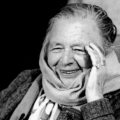The Space Between: A Personal Essay of Anorexia

The history of anorexia as a phenomenon is unclear, but the term “anorexia” seems to have become popularized in the Western lexicon sometime in the early nineteen eighties, as a result of Karen Carpenter’s death, caused by her battle with the illness. There was relatively little information available to the public then. Hilde Bruch, a German-born psychoanalyst, had begun her research into eating disorders in 1937, after fleeing anti-Semitism in Europe for the United States, and published the results of her studies on anorexia, The Golden Cage, in 1978. Salvador Minuchin, a family therapist, published his book detailing the causes and possible treatments for the illness, Psychosomatic Families: Anorexia Nervosa in Context, in 1978 as well. Then the American psychoanalyst Steven Levenkron, who began his research into anorexia around 1970, published a popular novel about a young anorexic woman, The Best Little Girl in the World, in 1981.
For many years, these three books stood alone. There were essentially no other non-academic texts on the market. It wasn’t until the late 1980s and early 1990s that the term anorexia became a household word—albeit one linked, most commonly, to movie stars or teenage girls. These days when I visit the bookstore, I’m amazed at the overwhelming number of eating disorder–related self-help books and memoirs. At the same time, research-based texts seem to have become more difficult to find.
The more recent proliferation of tell-all books, which generally lack much insight into the illness itself, focus on the disorder’s harrowing symptoms. These titles tend to ignore arguments about the origin of anorexia, its treatment, and its subtleties—a strange set of blind spots for a book about a life-threatening illness.
What’s most unsettling, though, is the way these memoirs reinforce stereotypes about anorexia, or worse, propagate harmful myths about the disease. In her 2013 memoir of anorexia, for example, How to Disappear Completely, Kelsey Osgood writes: “Anorexia is contagious, I explain to those with whom I dialogue. It is a behavior that can be learned through stories. It doesn’t necessarily develop organically or rise from the unknowing adolescent like a hysterical religious fervor of the ‘fasting girls’ of yore.”
Osgood argues both that eating disorders are not quote-unquote real maladies and that she is, in fact, the real thing. She places the blame for eating disorders on those who share images of anorexic people in the public domain, including survivors who share their experiences in memoirs. “This is the major difference between memoirs of anorexia and bulimia and memoirs of other addictions,” she writes. “Rarely, if ever, will a heroin addict, sick or recovering, seek out the memoir of a drug addiction in order to learn how to become a better practicing addict.”
The book reads like a series of contradictory blog entries. Osgood spends much of her memoir enacting the clichés of anorexia. Foremost among them: that anorexics come only from white upper/middle class families, and that class pressures trigger or generate the disorder itself. She spends many pages describing her own privileged background:
Where I am from everything is pretty. Driveways lined with perfectly curved trees lead to houses that sit on cushy green lawns. The train station is just far enough away that the houses don’t rattle with each passing freight but close enough that we can hear their faint ramblings in the middle of our darkest nights. In the mornings, these trains carry our fathers, who wear well-tailored suits and read the morning paper, off to the city, returning them back home at night. Our mothers are thinner than our teenagers because they play tennis during the days. […] Even our dogs are handsome, fit and well- groomed with shiny, lustrous coats made for televisions screens.
It has been argued that eating disorders are not taken seriously by the American public because of the extent to which they have been trivialized in the media. The afflictions are treated as a side-effect of privilege, luxury, and vanity. We’re told only rich white girls and movie stars “get” anorexia; that anorexia and bulimia are just attempts at losing weight; that in the end, eating disorders are nothing but diets and diets are for people who are vain and have no real concerns (i.e. they are not poor, don’t have “real world problems”).
“The first thing is we need to stop touting the anorexic population as misunderstood,” writes Osgood. “Surely, as individuals they often are, but as far as the general myths go, we need to figure out precisely which ones to debunk. The most popular myth has always been the characterization of anorexics as white, upper middle-class and female.” Here as elsewhere in the book, Osgood contradicts herself. Her own upper middle-class background undermines this attempt at social critique, serving instead to reinforce the stereotype, just as her attendance at an Ivy League college does. Osgood continues:
The second thing we need to do is try to cut the between [sic] genius and madness. While I am a white, female, from an upper-middle-class background and attended an Ivy League school, I can attest to the fact that there are most definitely superficial anorectics out there who possess only a paltry understanding of what the word “imagination” even means. Sometimes the ignorance is sweet, a puerile brain overtaken by a disease that belies the organ’s innocence or youth. Sometimes it is archetypal, belonging to a vacuous model or a disciplined, doltish athlete.
This way of thinking about the disease is common enough. Emma Woolf, in her memoir, An Apple a Day, which I reviewed last year for The Los Angeles Review of Books, also believes that eating disorders are contagious. She believes, as Osgood does, that anorexics are highly competitive and argues that this competition is so strong, when one anorexic meets another anorexic they immediately compare bodies, vying to be the thinnest. This competition, which Osgood refers to repeatedly in her book, seems to have got under her skin—in fact, she spends much of her book arguing that she is a “real” anorexic, compared to these others.
In a recent study out of the Douglas Mental Health University Institute Eating Disorders Program (EDP), in Montreal, Howard Steiger, Ph.D, head of the department along with Linda Booij, Ph.D, discovered that chronic anorexia can lead to genetic changes. A study forthcoming in the International Journal of Eating Disorders, shows “long-term anorexia nervosa in women is often associated with more pronounced alteration of genes that influence anxiety, social behavior, various brain and nervous system functions, immunity, and the functioning of peripheral organs.” According to Steiger:
These findings help clarify the point that eating disorders are not about superficial body image concerns or the result of bad parenting. They represent real biological effects of environmental impacts in affected people, which then get locked in by too much dieting.
Osgood’s thesis—that eating disorders are contagious, that images of emaciated girls and women will make anyone want to starve—beyond first assuming that anyone would want to suffer, both diminishes the suffering of the anorexic and denies the biological mechanisms that drive and maintain the compulsions.
One is always an anorexic. The disease persists, inscribed in one’s genetic structure and as a method of living, long after the physical component of the illness has been overcome.
For nearly thirty years now, I have lived with anorexia. For me, the disease was triggered by a traumatic event. A man took control over my body, and although I survived, the experience ignited something inside me, a panic, an unraveling, an idea I had never had before was introduced to my conscious: that I was unsafe. It was not safe for me in this world. And the only thing that stopped this panic was control, and I found that control in what I put into my mouth, my body.
The mere experience of control stopped the panic, the unraveling, for me. It was a kind of addiction. I had never read anything about anorexia—or about any eating disorder for that matter. My eating disorder was an organic survival mechanism. It nearly killed me, many times, but it was also the thing that helped me survive. The thought—If I can control my body I will be safe—saved me. I am alive today because the eating disorder grew into me. Thank God for the eating disorder.
But I have now lived with an eating disorder longer than I have not, and over those years the eating disorder or, rather its residue, has mutated. Despite years of therapy, a voice in my head tells me that if I ate less, took up less space, life would be easier, safer.
Despite the number of memoirs about anorexia available today, the voices of women who suffer most seriously are typically excluded. Living their lives with a life-long disability, these women often struggle with poverty and social exclusion. They’re often women of color, or white women from working class families. Their voices are marginalized, or simply omitted, from the literature of the disease. According to the National Eating Disorders Association:
Over the past few years, there has been increasing evidence of disordered eating occur ring among racial and ethnic minorities in the United States. Contrary to the persistent belief that eating disorders affect only young, white women, analysis of the Minnesota Adolescent Health Study found that dieting was associated with weight dissatisfaction, perceived overweight, and low body pride in all ethnic groups.
Similarly, a study conducted by Robinson et al, found that among the leanest 25% of 6th and 7th grade girls, Hispanics and Asians reported significantly more body dissatisfaction than did white girls. In a survey of 6,504 adolescents, Asian, Black, Hispanic and Caucasian youth all reported attempting to lose weight at similar rates, while among of Native American adolescents, 48.1% were attempting weight loss.
The issue is not that eating disorders occur predominantly among young white women, but that non-white women are simply not being diagnosed as the result of this bias.
Osgood’s memoir is an especially egregious case, spreading harmful myths about the nature of the disease, but other recent books have offered a different, more intellectual take on the condition. For instance, in Sarah Gerard’s novel, Binary Star—which tells the tragic story of an anorexic in a complicated relationship with a man who appears to be bipolar—the author explores the idea of “the space between.” On one level, this is the space exists between the main character and her boyfriend. It’s the space between understanding and confusion, between two human beings, and the space resulting from both of their mental illnesses. But anorexics experience another space, a separation.
Like Osgood, Gerard equates anorexia with the media: dropping references to magazines and movie stars throughout the book. The very nature of anorexia is that one is not aware of one’s thinness, hence the desire to lose just a little more weight. So though the wish to weigh 85 pounds might seem insane to a non-anorexic, it makes complete sense to an anorexic who weighs 90 pounds and still sees herself as overweight.
Gerard’s representation of anorexia is abstracted. Much of the prose breaks off into what amount to pages of stream-of-consciousness:
I stand in the diet aisle. Hydroxycut. Lipozene. alli. EAC. Metabolife. Sense. ReNew. Natrol. Zantrex-3. Slim-Quick. QuickTrim. Mega-T. Slim FX. PhytoGeniX. Xenadrine. Dexatrim. Thermonex. NitroVarin. Stacker. Labrada. Irwin Naturals Triple-Tea Fat Burner Softgels. I stand at the counter. Christina Ricci. Nicole Richie. Portia di Rossi. Mary Kate and Ashley. That’ll be twenty. Mischa Barton. Victoria Bechkham. Bethenny Frankel. Allegra Versace. Is that all? Kelly Clarkson. Lily Allen. Keira Knightley. Ginger Spice. Credit or debit. Lindsay Lohan. Lady Gaga. Fiona Apple. Isabelle Caro, who’s dead. Felicty Huffman. Calista Flockhart. Tara Reid.
Anorexia itself, in this context, becomes a concept. The affliction becomes reduced to a fetish—something both titillating and grotesque, something that creates an aspect of suspense while keeping our attention. The topic never becomes entirely explicit, nor does it ever become truly embodied. Though the book is unlike Osgood’s in many ways, both texts purport to navigate the topic while keeping it at arm’s length, simultaneously employing the same old stereotypical tropes.
In Writing Size Zero, Isabelle Meuret writes that starvation can be understood as a kind of writing on the body. She asserts that anorexia is a means to express the pain of the space between themselves and other people, which occurs to those experiencing hybridity:
The narrator’s double identity—French and Algerian—mangles her body. According to Amin Maalouf, the deadly aspect of hybridity is that it is constantly represented as an assemblage of multiple identities and not as one identity fashioned by different elements. The unfortunate consequence of this is that an individual is always urged to choose one of them as predominant or authentic.
“Neither female, nor male, neither from here, nor from there, the anorexic is an in-between creature.” Between genders, between races and classes—this has been my own experience. But though this definition may not fit all sufferers of anorexia, the sense of being outside of, or in-between, I think does. And even when the illness is treated, when the physical manifestations have gone, still this sensation remains—the stain, the place where the illness took root.
Is it possible that there really are two categories of eating disorder in the United States? One form that is, in fact, a mental illness, one that affects people from all class and race backgrounds? And then a second type, the type Osgood writes about, which grow from an understanding of what the anorexic looks like and the attention they imagine looking like that will bring?
I’m not convinced. An eating disorder is a mental illness. It’s neither contagious nor generated by magazines and books. Like all mental illnesses, each day is a reprieve. And like all mental illnesses, it is deadly and serious. Not a competition, not a trend, not an exotic element to be appropriated. It’s a form of speech. A voice. A response.
About Cynthia Cruz
Cynthia Cruz is the author of Wunderkammer (Four Way Books, 2014), The Glimmering Room (Four Way Books, 2012), and Ruin (Alice James, 2006). She has published poems in The New Yorker, Kenyon Review, The Paris Review, the Boston Review, and elsewhere.





